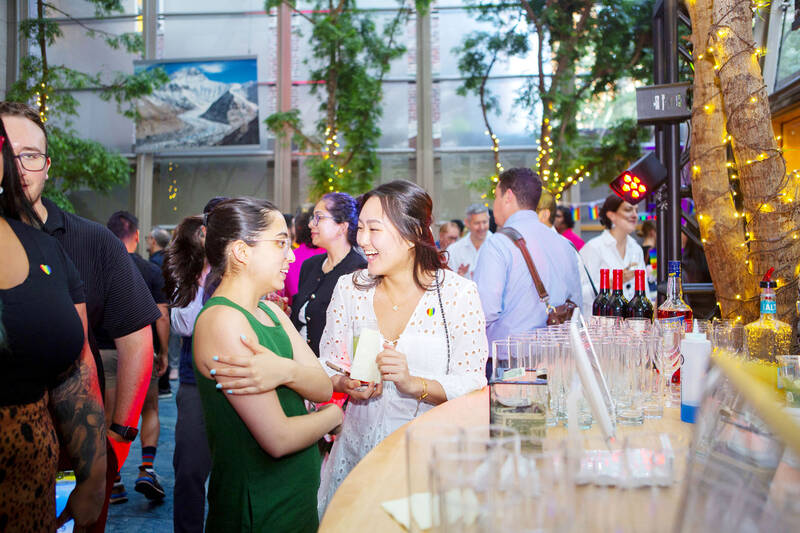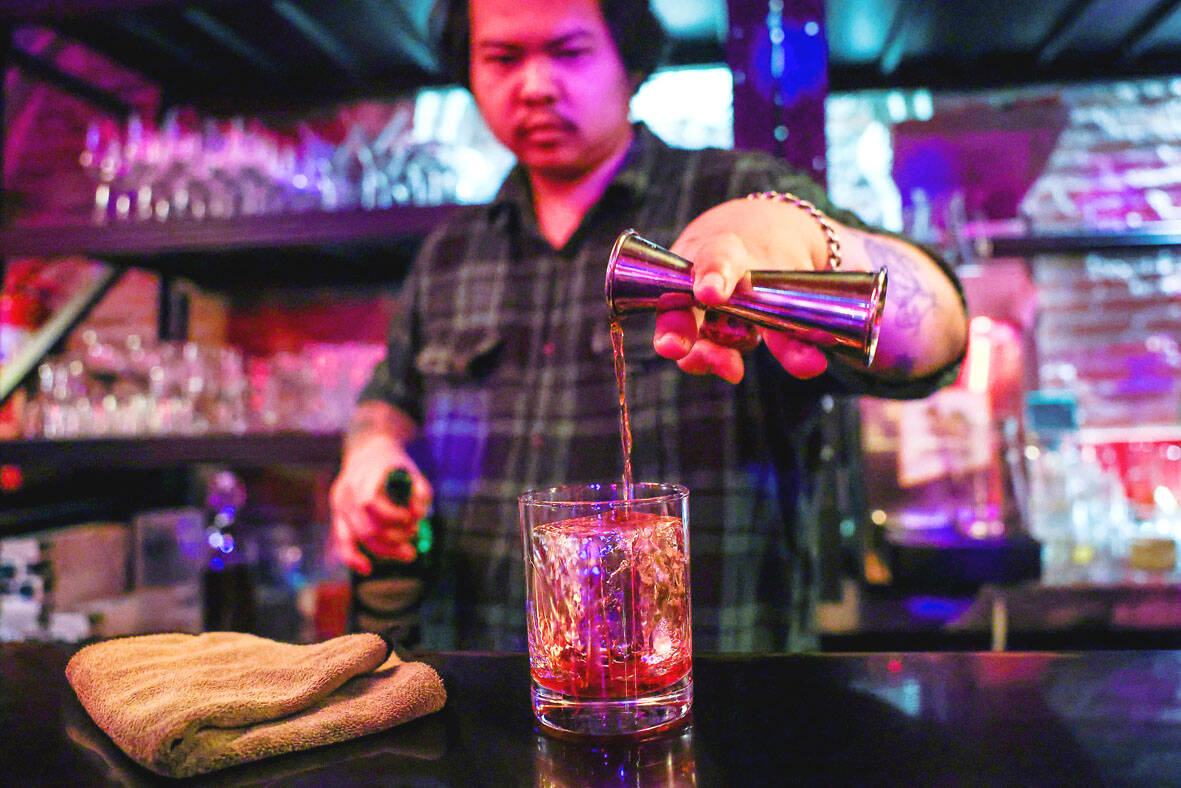You can tell a lot about a generation from the contents of their cool box: nowadays the barbecue ice bucket is likely to be filled with hard seltzers, non-alcoholic beers and fluorescent BuzzBallz — a particular favorite among Gen Z.
Two decades ago, it was WKD, Bacardi Breezers and the odd Smirnoff Ice bobbing in a puddle of melted ice. And while nostalgia may have brought back some alcopops, the new wave of ready-to-drink (RTD) options look and taste noticeably different.
It is not just the drinks that have changed, but drinking habits too, driven in part by more health-conscious consumers and demand for variety, according to Marten Lodewijks, the president of the drinks market analysts IWSR US.

Photo: AP
“A decade ago, hard seltzers, with less sugar and a lower ABV [alcohol by volume], appealed to a new, more health-conscious consumer that didn’t want quite as much sweetness. Lower calories also meant less flavor, however, and, as with any trend, a countertrend soon emerged,” he said.
Companies responded with a “much wider range of ABVs, flavors, sweetness levels and even carbonation.”
BACARDI BREEZERS TO BUZZBALLZ

Photo: Reuters
BuzzBallz, founded by a teacher and inspired by a snow globe, is among the newer arrivals tapping into that shift.
The instantly recognizable palm-sized spheres “climbed to become the number 18 RTD brand by volume in the UK,” Jess Scheerhorn, the vice-president at BuzzBallz, told the Drinks Business magazine, citing data from Circana, the US market research group.
The growing popularity of RTD products reflects a shift towards more casual, convenient drinking, often outside traditional settings such as pubs, Alice Baker, a senior research analyst at Mintel, said.
“Sales of RTDs have shot up from around £530 million [US$721,000] a decade ago to an estimated £970 million in 2024,” she said, with many people buying them as “a money-saving alternative to cocktails in pubs and bars.”
SOCIAL DRINKERS
The drinks company Diageo is aiming to make its classic brands such as Smirnoff, Guinness and Captain Morgan relevant to Gen Z drinkers, whom it suggests are wrongly perceived to be less interested in alcohol.
Giles Hedger, its global consumer planning director, said: “A lot of people talk about Gen Z being a cohort that is moving away from alcohol. Our data tells us otherwise. While they drink socially a little less frequently than other cohorts, they do so very enthusiastically.”
In fact, “Gen Z is super-committed to socializing,” he says, with alcohol a “very significant and enthusiastic part of that.”
According to Diageo, whose data draws on 150 consumer experts around the world and reams of market research, Gen Z do half their drinking in pubs and clubs and are fans of “three-hour-plus” occasions. They also “love spirits” and have a soft spot for cocktails.
Diageo has revamped Smirnoff Ice amid runaway demand for pre-mixed drinks. The 2000s alcopop has a new look and comes in a can, but according to the marketers, it still has the “citrus flavor notes that people know and love.”
Looks matter too — especially for a social media-savvy generation, Kiti Soininen, Mintel category director of UK food and drink research, said. “Our research shows that 73 percent of white spirits drinkers think that using visually appealing glassware makes drinking white spirits more enjoyable — which no doubt works in favor of BuzzBallz.”

In recent weeks the Trump Administration has been demanding that Taiwan transfer half of its chip manufacturing to the US. In an interview with NewsNation, US Secretary of Commerce Howard Lutnick said that the US would need 50 percent of domestic chip production to protect Taiwan. He stated, discussing Taiwan’s chip production: “My argument to them was, well, if you have 95 percent, how am I gonna get it to protect you? You’re going to put it on a plane? You’re going to put it on a boat?” The stench of the Trump Administration’s mafia-style notions of “protection” was strong

Every now and then, it’s nice to just point somewhere on a map and head out with no plan. In Taiwan, where convenience reigns, food options are plentiful and people are generally friendly and helpful, this type of trip is that much easier to pull off. One day last November, a spur-of-the-moment day hike in the hills of Chiayi County turned into a surprisingly memorable experience that impressed on me once again how fortunate we all are to call this island home. The scenery I walked through that day — a mix of forest and farms reaching up into the clouds

With one week left until election day, the drama is high in the race for the Chinese Nationalist Party (KMT) chair. The race is still potentially wide open between the three frontrunners. The most accurate poll is done by Apollo Survey & Research Co (艾普羅民調公司), which was conducted a week and a half ago with two-thirds of the respondents party members, who are the only ones eligible to vote. For details on the candidates, check the Oct. 4 edition of this column, “A look at the KMT chair candidates” on page 12. The popular frontrunner was 56-year-old Cheng Li-wun (鄭麗文)

“How China Threatens to Force Taiwan Into a Total Blackout” screamed a Wall Street Journal (WSJ) headline last week, yet another of the endless clickbait examples of the energy threat via blockade that doesn’t exist. Since the headline is recycled, I will recycle the rebuttal: once industrial power demand collapses (there’s a blockade so trade is gone, remember?) “a handful of shops and factories could run for months on coal and renewables, as Ko Yun-ling (柯昀伶) and Chao Chia-wei (趙家緯) pointed out in a piece at Taiwan Insight earlier this year.” Sadly, the existence of these facts will not stop the